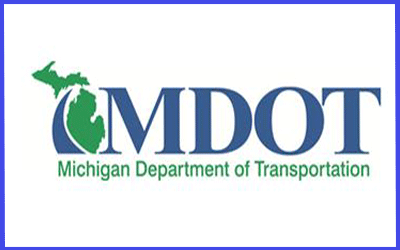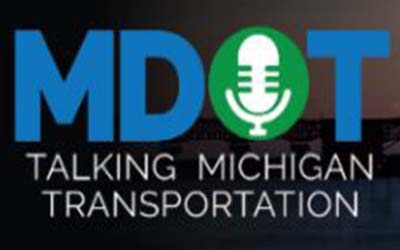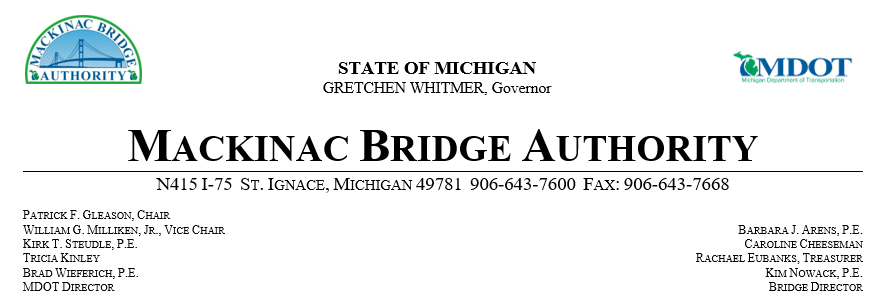
by orionontv | Mar 26, 2024 | Transportation
Annual spring weight restrictions
changing on Michigan’s roads
LANSING, Mich. - The Michigan Department of Transportation (MDOT) continues to adjust spring weight restriction areas in an annual move to protect roads.
Effective 6 a.m. Monday, April 1, weight restrictions will be lifted on all state trunkline highways from the southern Michigan border north to and including US-2/US-141 at the Menominee River bridge west of Iron Mountain then east on US-2 to St. Ignace, then north on I-75 to M-134, then east to and including M-134 on Drummond Island.
Frost restrictions are still in effect for the remainder of the state and will be imposed and enforced on all state trunkline highways north of US-2, I-75, and M-134 and on M-185 on Mackinac Island. State routes typically carry M, I, or US designations.
In the restricted areas, the following will apply:
- On routes designated as “all-season” (designated in green and gold on the MDOT Truck Operators Map), there will be no reduction in legal axle weights.
- All extended permits will be valid for oversize loads in the weight-restricted area on the restricted routes. Single-trip permits will not be issued for any overweight loads or loads exceeding 14 feet in width, 11 axles, and 150 feet in overall length on the restricted routes.
- On routes designated as “seasonal” (designated in solid or dashed red on the MDOT Truck Operators Map), there will be a posted weight reduction of 25 percent for rigid (concrete) pavements and 35 percent for flexible (asphalt) pavements, and maximum speed of 35 mph for some vehicles.
Drivers must follow the speed limits for weight restricted roads, per state law. Go online for speed restrictions for trucks and the rules for propane fuel delivery and public utility vehicles.
When roads that have been frozen all winter begin to thaw from the surface downward, melting snow and ice saturate the softened ground. During the spring thaw, the roadbed softened by trapped moisture beneath the pavement makes it more susceptible to damage. This contributes to pothole problems already occurring due to this winter’s numerous freeze-thaw cycles.
MDOT determines when weight restrictions begin each spring by measuring frost depths along state highways, observing road conditions, and monitoring weather forecasts. Weight restrictions remain in effect until the frost line is deep enough to allow moisture to escape and the roadbeds regain stability.
County road commissions and city public works departments put in place their own seasonal weight restrictions, which usually, but not always, coincide with state highway weight restrictions. Signs are generally posted to indicate which routes have weight restrictions in effect.
For weight restriction information and updates, call 800-787-8960, or you can access this information on MDOT’s website at www.Michigan.gov/Truckers, under “Restrictions.” All-season routes are designated in green and gold on the MDOT Truck Operators Map, which is available online. You also may sign up to receive e-mail alerts.
Trucking companies located in New Jersey and Canada can obtain information by calling 517-373-6256.
###
Work zones are temporary,
Bad decisions behind the wheel can last forever.


by orionontv | Mar 21, 2024 | Transportation

by orionontv | Mar 18, 2024 | Transportation
Eastbound Blue Water Bridge improvements shifting all traffic to westbound bridge starting May 29
– The Michigan Department of Transportation (MDOT) will complete maintenance on the eastbound span of the Blue Water Bridge (BWB) May 29 to October.
– This work will close the eastbound span of the BWB from the U.S. to Canada, carrying both directions of traffic on the westbound bridge span.
– During work, wide loads will be restricted to less than 10 feet and dedicated lanes for commuter pass holders and buses will not be accommodated.
PORT HURON, Mich. - Beginning May 29, the Michigan Department of Transportation (MDOT) will close the eastbound span of the Blue Water Bridge (BWB) to complete maintenance. This project will be managed by MDOT, and address required maintenance on the eastbound BWB span connecting Port Huron, Michigan, and Point Edward, Ontario.
To reduce impacts on traffic, both directions of BWB traffic will be carried on the westbound span. One outgoing lane will be reserved for eastbound traffic heading into Canada, becoming two lanes after center span. One outgoing lane will be reserved for westbound traffic heading into the U.S. and becoming two lanes after center span. MDOT is coordinating this work with maintenance the Federal Bridge Corporation Limited (FBCL) will complete to reduce impacts to customers.
While the westbound BWB span carries both directions of traffic, the following impacts should be expected:
- Dedicated lanes for commuter pass holders and buses cannot be accommodated.
- Wide loads will be restricted to less than 10 feet.
The BWB is an essential economic link between Canada and the United States. This important project continues the commitment between MDOT and FBCL to maintain and preserve the safety and reliability of the BWB.
For more information:
Dave Smith
MDOT Blue Water Bridge
810-434-3274
SmithD134@Michigan.gov
Jocelyn Garza
MDOT Communications Specialist
989-245-7117
GarzaJ10@Michigan.gov

by orionontv | Mar 14, 2024 | Transportation
FOR IMMEDIATE RELEASE MEDIA CONTACT
March 14, 2024 Diane Cross
CrossD2@Michigan.gov
This weekend’s planned traffic shift for I-75 project
in northern Oakland County delayed
VILLAGE OF CLARKSTON, Mich. – Due to unforeseen delays, the traffic shift planned for the I-75 project between M-15 (Ortonville Road) and the Oakland/Genesee county line this weekend is cancelled. The traffic shift instead will occur mid- to late next week. Once in place, there will be two lanes of traffic in each direction on the existing southbound I-75 lanes throughout construction.
Upcoming Closures:
Beginning 3 a.m. Wednesday, March 20, through 11:59 p.m. Thursday, Oct. 31:
- Northbound and southbound I-75 will have two lanes open in each direction between M-15 and Baldwin Road with traffic shifted to the southbound I-75 side of the freeway.
- The following entrance ramps will be closed:
- Northbound M-15 to northbound I-75
- Southbound M-15 to northbound I-75
- Northbound Dixie Highway to northbound I-75
- Southbound Dixie Highway to northbound I-75
- East Holly Road to northbound I-75
- Dixie Highway (Mile Marker 106) to northbound I-75
- Only the northbound I-75 Exit 101 ramp to Grange Hall Road will be closed. All other exits on northbound I-75 will be open.
- The Davisburg Rest Area on northbound I-75 will be closed.
As the work is weather dependent, it might get pushed until the following weekend.
Current Closures:
- Southbound I-75 will be reduced to one lane for barrier wall setting from Baldwin Road to M-15 through Tuesday, March 19.
- Southbound I-75 Exit 106 to Saginaw Road is closed through late fall.
- The Saginaw Road entrance ramp to southbound I-75 (Mile Marker 106) is closed through late fall.
- The Dixie Highway entrance ramp to southbound I-75 (Mile Marker 93) will be closed though late fall.
Funding for this project is made possible by Gov. Gretchen Whitmer’s Rebuilding Michigan program to rebuild the state highways and bridges that are critical to the state’s economy and carry the most traffic. The investment strategy is aimed at fixes that result in longer useful lives and improve the condition of the state’s infrastructure.
The Michigan Department of Transportation (MDOT) is investing approximately $160 million to resurface and repair I-75 from M-15 (Ortonville Road) to the Oakland/Genesee county line. This project includes resurfacing I-75, repairing 11 bridges, drainage improvements, culvert replacements, signs, and guardrail. Various work will be performed in different locations with different schedules throughout the 15 miles over four years.
Based on economic modeling, this investment is expected to directly and indirectly support 1,936 jobs.

by orionontv | Mar 14, 2024 | Transportation
FOR IMMEDIATE RELEASE
March 14, 2024
|
|
MEDIA CONTACT
Courtney Bates
517-242-0950
BatesC@Michigan.gov |
MDOT introduces statewide Paint the Plow program for
Michigan high schools
LANSING, Mich. – The Michigan Department of Transportation (MDOT) is now accepting applications for the 2024-25 Paint the Plow program. This program offers a unique opportunity for MDOT to partner with area schools, using students’ creativity to communicate safe winter driving practices for all Michigan residents.
The Paint the Plow program is open to all Michigan high schools, including technical and vocational programs. Students are invited to submit a creative and original design, reflecting their individual school, while promoting a selected safety theme. This year’s safety theme is “Go hands-free. Just drive. It’s the law.”
The safety theme serves as a reminder to motorists that new legislation has made it illegal to hold and use an electronic device while driving in Michigan. While the legislation has been in place since June 2023, drivers across the state continue to engage in unsafe driving practices using electronic devices. Communicating the importance of this message on MDOT plow blades tasked with clearing our roads of ice and snow through the winter will serve as an additional reminder of the responsibility all drivers must take when operating their vehicle.
MDOT will accept Paint the Plow design applications through Friday, May 17. Selected schools will be notified before the end of the 2024 school year and arrangements will be made for the delivery of their plow blade in the fall. Dependent on location through the state, schools will have approximately six weeks to complete their design before MDOT staff return for the completed plow blade in time to ready trucks for the winter maintenance season. Painted plow blades will be visible along various state trunklines in Michigan through the winter.
Interested schools can visit www.Michigan.gov/PaintThePlow for more information, and to submit their design.
###
Work zones are temporary,
Bad decisions behind the wheel can last forever.

Photo: Ovid-Elsie High School honors art students completed a design for the 2023-2024 pilot season of MDOT’s Paint the Plow program, incorporating the safety message, “Don’t rush in ice and slush.”

by orionontv | Mar 11, 2024 | Transportation

Repaving on Mackinac Bridge starts March 25
ST. IGNACE, Mich. – The Mackinac Bridge Authority (MBA) will begin a two-season repaving project on the bridge’s north viaduct and approach truss spans March 25, weather permitting.
Repaving, deck repairs, and joint repairs on the two northbound lanes of the bridge will begin March 25 and is scheduled to be completed by May 23. Traffic will be maintained with one lane open in each direction during construction. All lane closures will be lifted after May 23.
Work has been scheduled to help minimize delays to traffic and disruptions to special events on the bridge.
“As with any construction in northern Michigan, the best weather unfortunately coincides with the highest traffic volumes,” said MBA Chief Engineer Cole Cavalieri. “We’re glad we’ve been able to schedule this work to occur before traffic peaks for the summer to reduce delays for travelers.”
Weekend traffic peaks between 10 a.m. and 4 p.m., often resulting in traffic backups, even with all toll lanes open. Drivers should consider crossing at off-peak times or prepare for delays.
Wide-load restrictions will be in place in both directions for any vehicles wider than 10 feet during construction. Wider loads will be allowed to cross once per day between 7 and 8 p.m. Monday through Thursday, and traffic will be stopped for brief periods for those crossings.
Due to this work, the St. Ignace Visitors Bureau’s annual Jeep the Mac event will not include a bridge crossing. Instead, the Bureau has renamed the event, Jeep the Yoop, scheduled for May 10-12.
Work will resume in late March 2025 with repaving of the two southbound lanes. The overall project is scheduled to be completed, with all lanes reopened, by May 22, 2025.
The MBA’s sole source of funding is from tolls and fees collected, with all revenue used to maintain, operate, and protect the bridge. Live traffic camera views of the bridge, updates on bridge conditions, toll rates, and information on the MacPass program can all be found on the MBA website: www.MackinacBridge.org.












